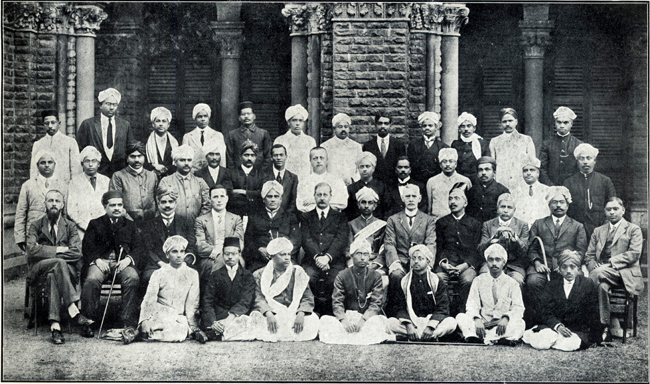S.Narayana Aiyar
Chief Accountant and
Mathematical Friend of Ramanujan
Abstract
S.Narayana Aiyar was chief accountant at the Madras Port Trust office, where Ramanujan worked as a clerk in 1912–1914. In this article, a short biography of S.Narayana Aiyar is given, his mathematical contributions are discussed, and his personal and mathematical relationships with Ramanujan are examined and emphasized.
1. Introducing S.Narayana Aiyar
You can read this material in the excerpt (pp.767-776) from the Nov 2011 issue of 'The American Mathematical Monthly' [ 7.6 MB pdf file].
2. Cultural Background
ibid. Nov 2011 issue of 'The American Mathematical Monthly' [ 7.6 MB pdf file].
3. Life Story
S.Narayana Aiyar was born on December 15, 1874 in Cumbum, near Madurai in Tamil Nadu. (The initial S. stands for his father’s name Subbanarayanan.) His parents, Subbanarayanan Iyer and Lakshmi, were poor. Both his father and paternal grandfather, Ananthanarayana Iyer, were Hindu priests, well versed in Sanskrit and the Vedas, and made their livings conducting Hindu rituals in private homes. Narayana Aiyar’s family was so poor that once during his early school days, at the annual school inspection, he had to share his only shirt with his elder brother. Having struggled in his early life, he held a lifelong affectionate concern for the welfare of the poor and everyone with whom he worked. He had one elder brother and three sisters. Narayana Aiyar earned an M.A. in mathematics from St.Joseph’s College in Trichinopoly, one of the premier colleges in southern India at that time. In those days, the M.A. degree was the highest degree that was offered in any subject in the absence of the Ph.D., which was introduced only many years later. While teaching at St.Joseph’s College, Narayana Aiyar became known to Francis Spring, who at that time was serving with the railways in Trichinopoly. In 1900, Narayana Aiyar was asked to become office manager at the Madras Port Trust office, at the invitation of Francis Spring, who by that time had become chairman of the Madras Port Trust, who was to be knighted in 1911, and who was to become one of Ramanujan’s most ardent supporters. In due course, Narayana Aiyar was promoted to chief accountant, his position at the time of Ramanujan’s application for employment as a clerk in February, 1912, and thus became the highest-ranking Indian at the Port Trust, where he served until his retirement in 1934. In recognition of his service, the government awarded him the title of “Rao Bahadur,” a title of honor issued by the British to individuals who had performed great service to the nation.
Narayana Aiyar and his wife Avibakthanayaki had two daughters, Meenakshi and Kamakshi, and one son, Subbanarayanan. In 1925, Narayana Aiyar’s son-in-law (husband of Kamakshi), M.S.Venkataraman (1902–1967), was appointed to fill a vacancy in the Madras Port Trust office. At the time of Indian independence in 1947, he was traffic manager and then became the first Indian to officiate as chairman of the Madras Port Trust. Upon assuming the post, he gathered together all of the files connected with Ramanujan and transferred them to the National Archives in New Delhi. Copies of these papers were secured for the present author by Nobel laureate S. Chandrasekhar, and many are reproduced in the author’s book Ramanujan: Letters and Commentary, coauthored with R.A.Rankin [7]. Narayana Aiyar’s son, Subbanarayanan, also joined the Madras Port Trust, serving as assistant section master and retiring as office manager.
4. Mathematical Contributions
please download pp767-776 of the Nov 2011 issue of 'The American Mathematical Monthly' [ 7.6 MB pdf file]. The full issue is available at www.jstor.org
1919 Meeting of the
Indian Mathematical Society
in Mumbai

Harbour S.Narayana Aiyar is 3rd from the left in first row
S.Narayana Aiyar was one of the delegates to the 1919 meeting
of the Indian Mathematical Society in Mumbai
5. Epilogue
Except for a few family pictures, only one photograph of S.Narayana Aiyar is extant. Narayana Aiyar was one of the delegates to the meeting of the Indian Mathematical Society in Bombay in 1919, and so can be seen in this group photo. This photograph is extremely valuable, because many important people in the life of Ramanujan are present. These include (numbering from the left) S. Narayana Aiyar (3, first row), P. V. Seshu Aiyar (4, first row), V. Ramaswami Aiyar (5, second row), R. Ramachandra Rao (10, second row), and S. R. Ranganathan (2, third row). Ranganathan wrote the first book biography of Ramanujan in English [15]. He was the librarian at the University of Madras and is internationally recognized today as one of the founders of modern library science. Also mentioned in this article are M. T. Naraniengar (7, second row) and S. Narayanan (9, third row). For a recent account of the history of the Indian Mathematical Society and of mathematics in India during the past century, see the article by J. W. Dauben and R. Parikh [11].
7.
B.C.Berndt and R.A.Rankin, Ramanujan: Letters and Commentary, American Mathematical Society,
Providence, RI, 1995; London Mathematical Society, London, 1995
11. J.W.Dauben and R.Parikh, Beginnings of modern mathematics in India, Current Science 99 (2010) 300–322.
15. S.R.Ranganathan, Ramanujan: The Man and the Mathematician, Asia Publishing, Bombay, 1967.
